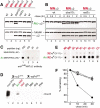N-terminal acetylation of cellular proteins creates specific degradation signals
- PMID: 20110468
- PMCID: PMC4259118
- DOI: 10.1126/science.1183147
N-terminal acetylation of cellular proteins creates specific degradation signals
Abstract
The retained N-terminal methionine (Met) residue of a nascent protein is often N-terminally acetylated (Nt-acetylated). Removal of N-terminal Met by Met-aminopeptidases frequently leads to Nt-acetylation of the resulting N-terminal alanine (Ala), valine (Val), serine (Ser), threonine (Thr), and cysteine (Cys) residues. Although a majority of eukaryotic proteins (for example, more than 80% of human proteins) are cotranslationally Nt-acetylated, the function of this extensively studied modification is largely unknown. Using the yeast Saccharomyces cerevisiae, we found that the Nt-acetylated Met residue could act as a degradation signal (degron), targeted by the Doa10 ubiquitin ligase. Moreover, Doa10 also recognized the Nt-acetylated Ala, Val, Ser, Thr, and Cys residues. Several examined proteins of diverse functions contained these N-terminal degrons, termed AcN-degrons, which are a prevalent class of degradation signals in cellular proteins.
Figures




Comment in
-
Cell biology. When the beginning marks the end.Science. 2010 Feb 19;327(5968):966-7. doi: 10.1126/science.1187274. Science. 2010. PMID: 20167776 No abstract available.
References
Publication types
MeSH terms
Substances
Grants and funding
LinkOut - more resources
Full Text Sources
Other Literature Sources
Molecular Biology Databases
Research Materials
Miscellaneous

